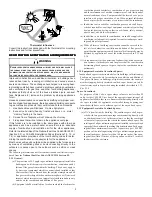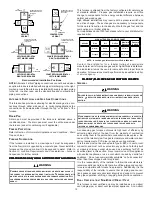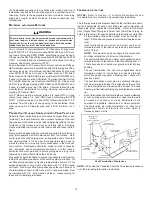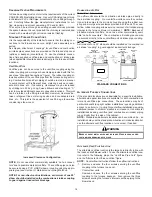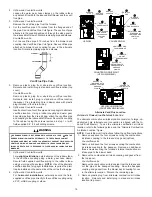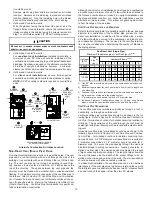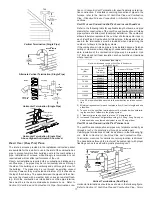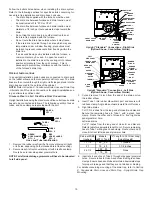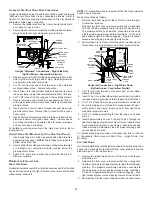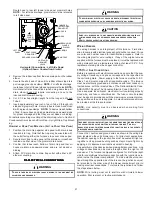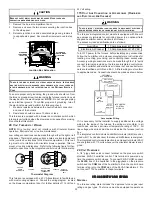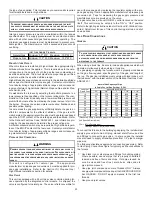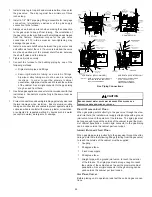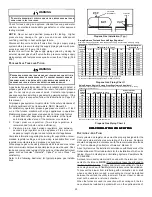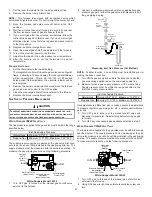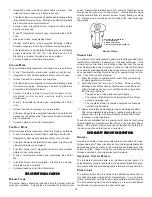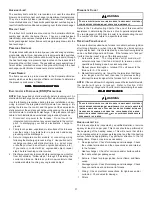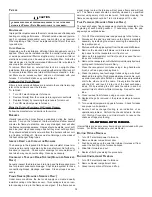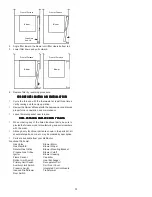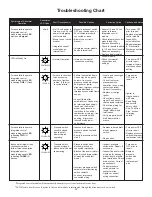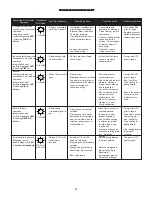
23
the type of gas applied. This includes any conversion kits required
for alternate fuels and/or high altitude.
CAUTION
T
O PREVENT UNRELIABLE OPERATION OR EQUIPMENT DAMAGE, THE INLET
GAS SUPPLY PRESSURE MUST BE AS SPECIFIED ON THE UNIT RATING PLATE
WITH ALL OTHER HOUSEHOLD GAS FIRED APPLIANCES OPERATING.
Inlet gas supply pressures must be maintained within the ranges
specified below. The supply pressure must be constant and avail-
able with all other household gas fired appliances operating. The
minimum gas supply pressure must be maintained to prevent unre-
liable ignition. The maximum must not be exceeded to prevent unit
overfiring.
Propane Gas
Natural Gas
Inlet Gas Supply Pressure
Minimum:5.0" W.C. Maximum :10.0" W.C.
Minimum:11.0" W.C. Maximum :13.0" W.C.
H
IGH
A
LTITUDE
D
ERATE
When this furnace is installed at high altitude, the appropriate High
Altitude orifice kit must be applied. This is required due to the natu-
ral reduction in the density of both the gas fuel and combustion air
as altitude increases. The kit will provide the proper design certified
input rate within the specified altitude range.
High altitude kits are purchased according to the installation altitude
and usage of either natural or propane gas. Contact your distributor
for a tabular listing of appropriate altitude ranges and correspond-
ing manufacturer’s high altitude (Natural, Propane Gas, and/or Pres-
sure Switch) kits.
Do
not
derate the furnace by adjusting the manifold pressure to a
lower pressure than specified on the furnace rating plate. The com-
bination of the lower air density and a lower manifold pressure will
prohibit the burner orifice from drawing the proper amount of air into
the burner. This may cause incomplete combustion, flashback, and
possible yellow tipping.
In some areas the gas supplier may artificially derate the gas in an
effort to compensate for the effects of altitude. If the gas is artifi-
cially derated, the appropriate orifice size must be determined based
upon the BTU/ft
3
content of the derated gas and the altitude. Refer
to the National Fuel Gas Code, ANSI Z223.1, and information pro-
vided by the gas supplier to determine the proper orifice size.
A different pressure switch may be required at high altitude regard-
less of the BTU/ft
3
content of the fuel used. Contact your distributor
for a tabular listing of appropriate altitude ranges and correspond-
ing manufacturer’s pressure switch kits.
P
ROPANE
G
AS
C
ONVERSION
WARNING
P
OSSIBLE PROPERTY DAMAGE, PERSONAL INJURY OR DEATH MAY OCCUR IF
THE CORRECT CONVERSION KITS ARE NOT INSTALLED.
T
HE APPROPRIATE KITS
MUST BE APPLIED TO INSURE SAFE AND PROPER FURNACE OPERATION.
A
LL
CONVERSIONS MUST BE PERFORMED BY A QUALIFIED INSTALLER OR SERVICE
AGENCY.
This unit is configured for natural gas. The appropriate
manufacturer’s propane gas conversion kit, must be applied for pro-
pane gas installations. Refer to the
Section VIII, Propane Gas /
High Altitude Installations
section for details.
G
AS
V
ALVE
This unit is equipped with a 24 volt gas valve controlled during fur-
nace operation by the integrated control module. As shipped, the
valve is configured for natural gas. The valve is field convertible for
use with propane gas by replacing the regulator spring with a pro-
pane gas spring from an appropriate manufacturer’s propane gas
conversion kit. Taps for measuring the gas supply pressure and
manifold pressure are provided on the valve.
The gas valve has a manual ON/OFF control located on the valve
itself. This control may be set only to the “ON” or “OFF” position.
Refer to the lighting instructions label or
Section XIV, Startup Proce-
dure & Adjustment
for use of this control during start up and shut
down periods.
G
AS
P
IPING
C
ONNECTIONS
G
ENERAL
CAUTION
T
O AVOID POSSIBLE UNSATISFACTORY OPERATION OR EQUIPMENT DAMAGE
DUE TO UNDERFIRING OF EQUIPMENT, USE THE PROPER SIZE OF
NATURAL/PROPANE GAS PIPING NEEDED WHEN RUNNING PIPE FROM THE
METER/TANK TO THE FURNACE.
When sizing a trunk line, be sure to include all appliances which will
operate simultaneously when sizing a trunk line.
The gas piping supplying the furnace must be properly sized based
on the gas flow required, specific gravity of the gas, and length of
the run. The gas line installation must comply with local codes, or in
their absence, with the latest edition of the National Fuel Gas Code,
ANSI Z223.1.
Natural Gas Capacity of Pipe
In Cubic Fee t of Gas Per Hour (CFH)
Length of
Nominal Black Pipe Size
Pipe in Feet
1/2"
3/4"
1"
1 1/4"
1 1/2"
10
132
278
520
1050
1600
20
92
190
350
730
1100
30
73
152
285
590
980
40
63
130
245
500
760
50
56
115
215
440
670
60
50
105
195
400
610
70
46
96
180
370
560
80
43
90
170
350
530
90
40
84
160
320
490
100
38
79
150
305
460
(Pressure 0.5 psig or less and pressure drop of 0.3" W.C.; Based on
0.60 Specif ic Gravity Gas)
CFH =
BTUH Furnace Input
Heating Value of Gas (BTU/Cubic Foot)
To connect the furnace to the building’s gas piping, the installer must
supply a ground joint union, drip leg, manual shutoff valve, and line
and fittings to connect to gas valve. In some cases, the installer
may also need to supply a transition piece from 1/2" pipe to a larger
pipe size.
The following stipulations apply when connecting gas piping. Refer
to
Gas Piping Connections
figure for typical gas line connections to
the furnace.
•
Use black iron or steel pipe and fittings for building piping.
Where possible, use new pipe that is properly chamfered,
reamed, and free of burrs and chips. If old pipe is used, be
sure it is clean and free of rust, scale, burrs, chips, and old
pipe joint compound.
•
Use pipe joint compound on male threads ONLY. Always
use pipe joint compound (pipe dope) that is APPROVED FOR
ALL GASSES. DO NOT apply compound to the first two
threads.
•
Use ground joint unions.

